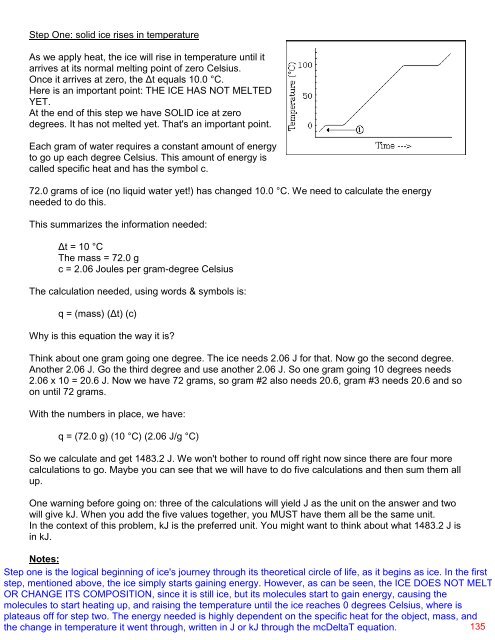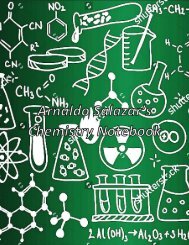Create successful ePaper yourself
Turn your PDF publications into a flip-book with our unique Google optimized e-Paper software.
Step One: solid ice rises in temperature<br />
As we apply heat, the ice will rise in temperature until it<br />
arrives at its normal melting point of zero Celsius.<br />
Once it arrives at zero, the Δt equals 10.0 °C.<br />
Here is an important point: THE ICE HAS NOT MELTED<br />
YET.<br />
At the end of this step we have SOLID ice at zero<br />
degrees. It has not melted yet. That's an important point.<br />
Each gram of water requires a constant amount of energy<br />
to go up each degree Celsius. This amount of energy is<br />
called specific heat and has the symbol c.<br />
72.0 grams of ice (no liquid water yet!) has changed 10.0 °C. We need to calculate the energy<br />
needed to do this.<br />
This summarizes the information needed:<br />
Δt = 10 °C<br />
The mass = 72.0 g<br />
c = 2.06 Joules per gram-degree Celsius<br />
The calculation needed, using words & symbols is:<br />
q = (mass) (Δt) (c)<br />
Why is this equation the way it is?<br />
Think about one gram going one degree. The ice needs 2.06 J for that. Now go the second degree.<br />
Another 2.06 J. Go the third degree and use another 2.06 J. So one gram going 10 degrees needs<br />
2.06 x 10 = 20.6 J. Now we have 72 grams, so gram #2 also needs 20.6, gram #3 needs 20.6 and so<br />
on until 72 grams.<br />
With the numbers in place, we have:<br />
q = (72.0 g) (10 °C) (2.06 J/g °C)<br />
So we calculate and get 1483.2 J. We won't bother to round off right now since there are four more<br />
calculations to go. Maybe you can see that we will have to do five calculations and then sum them all<br />
up.<br />
One warning before going on: three of the calculations will yield J as the unit on the answer and two<br />
will give kJ. When you add the five values together, you MUST have them all be the same unit.<br />
In the context of this problem, kJ is the preferred unit. You might want to think about what 1483.2 J is<br />
in kJ.<br />
Notes:<br />
Step one is the logical beginning of ice's journey through its theoretical circle of life, as it begins as ice. In the first<br />
step, mentioned above, the ice simply starts gaining energy. However, as can be seen, the ICE DOES NOT MELT<br />
OR CHANGE ITS COMPOSITION, since it is still ice, but its molecules start to gain energy, causing the<br />
molecules to start heating up, and raising the temperature until the ice reaches 0 degrees Celsius, where is<br />
plateaus off for step two. The energy needed is highly dependent on the specific heat for the object, mass, and<br />
the change in temperature it went through, written in J or kJ through the mcDeltaT equation. 135




